(UPDATE at 8:40 a.m. MDT July 15, 2016)
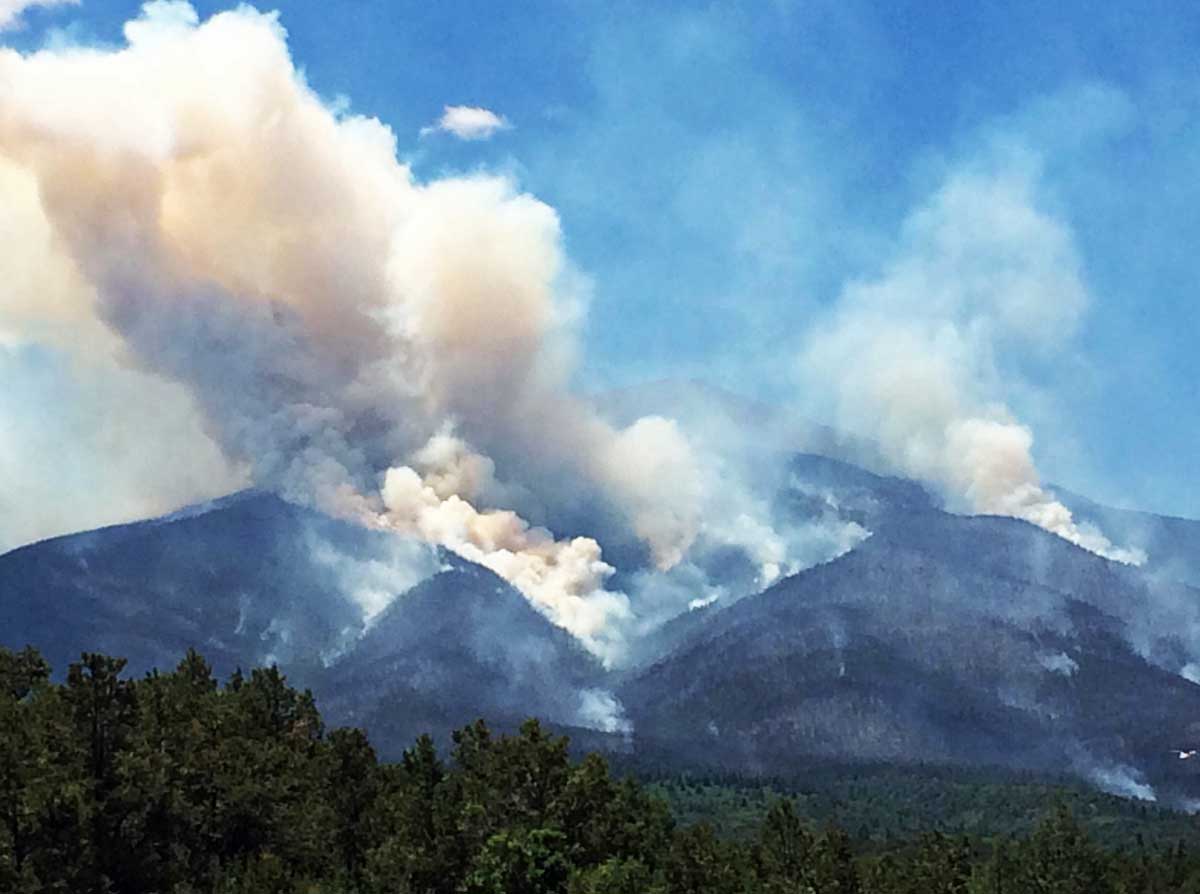
The Hayden Pass Fire near Coaldale, Colorado grew by about 1,000 acres on Thursday and has now burned approximately 15,700 acres.
The incident management team reported Thursday night that they received more helicopters and seemed to imply that suppression of the fire had been hampered by a shortage of aircraft:
Additional helicopters arrived, enabling firefighters to utilize seven ships this afternoon, performing water drops and vital reconnaissance for fires that begin outside the fire perimeter.
Evacuations, road, area and trail closures are in effect and one structure has been destroyed.
The fire has spread south towards the Lake Creek drainage and west of the Duckett fire scar of 2011. Structural protection teams are installing sprinkler systems and removing vegetation around some structures out ahead of the fire.
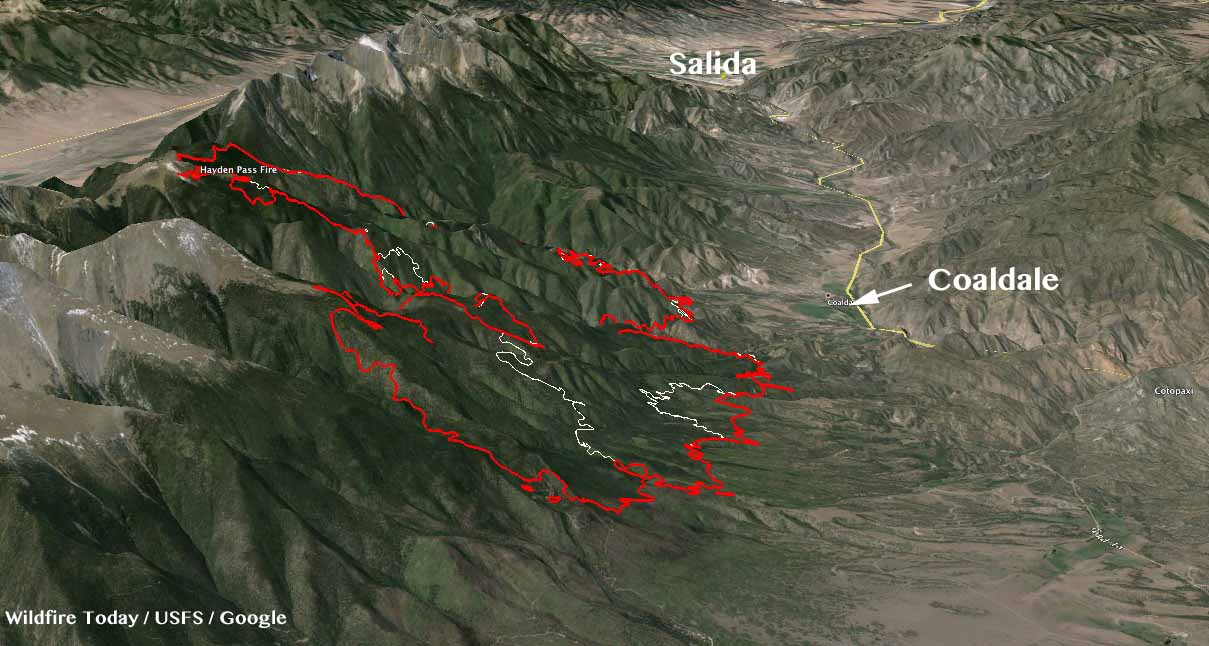
The weather forecast for the Coaldale area for Friday and Saturday predicts temperatures in the low to mid-80s, southwest winds at 8 to 10 mph, and relative humidities in the low teens with very little chance of rain. Parts of Colorado will be under Red Flag Warnings or Fire Weather Watches Friday and Saturday.
****
(UPDATE at 1:30 p.m. MDT July 14, 2016)
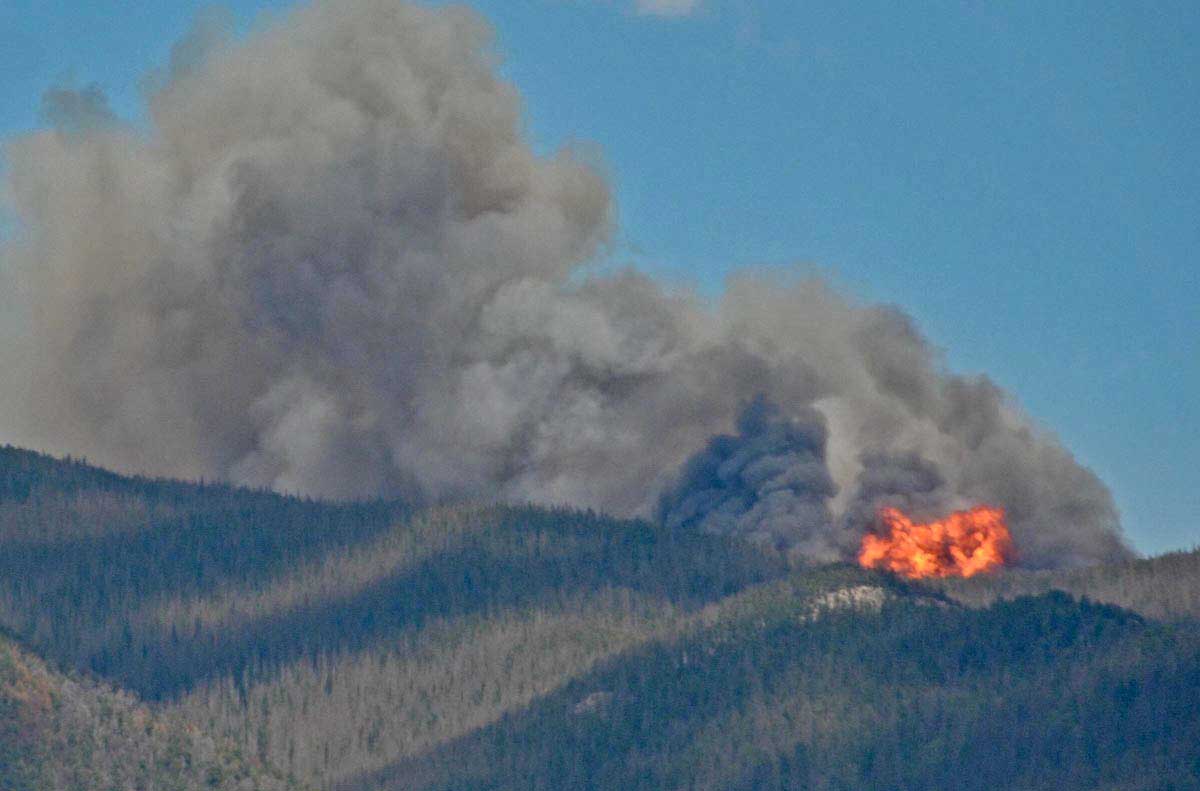
The incident management team for the Hayden Pass Fire issued the information below as part of a Thursday morning update:
…Crews are actively suppressing the fire outside of the Sangre de Cristo Wilderness utilizing structure defense, direct and indirect fire control strategies. Helicopters and air tankers are supporting these strategies, to include retardant drops for structural protection. Firefighting resources are shifting as priorities are completed and new risks are prioritized. Firefighters will continue to suppress the fire using resources and tactics to minimize firefighter risk with the highest probability of success.
The fire continues to burn in the Sangre de Cristo Wilderness. Crews are not currently engaging the fire within the wilderness due to complex terrain causing safety concerns; rather, they will closely monitor fire movement and assist Forest Service staff by informing recreationists of area closures…
The update on the fire posted today at InciWeb did not include the revised size of the fire. Members of the media who attended a press conference this morning reported it had grown to more than 14,500 acres.
The way the U.S. Forest Service describes the management strategy of these less-than-full-suppression wildfires is confusing — to the public and even some firefighters. Officially the Hayden Pass Fire is listed as a “monitor/confine/contain” fire rather than “full suppression” like most fires. But the agency and the Information Officers communicating with citizens do not like to discuss that publicly. It can be scary to some when they hear that the government is not pulling out all the stops in order to put out a fire quickly. And it can be disconcerting to think about a fire within sight of hundreds of homes burning from early July until October 1, which is the “completion” date for the Hayden Pass Fire listed in the excerpt below from the National Situation Report. (See “Cnt/Comp” which refers to Contain or Complete, with Contain being suppression, and Complete referring to less-than-full-suppression.)

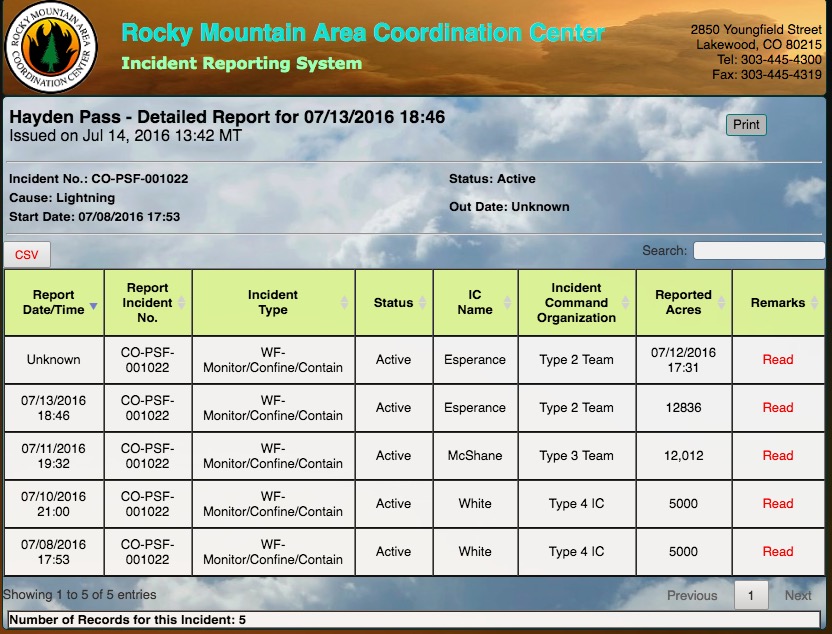

Below are two video briefings that were posted on Thursday. The first features Incident Commander Jay Esperance. Following that is Operations Section Chief Travis Lipp. Click on the full screen icons to see larger versions.
****
(UPDATE at 21:20 p.m. MDT July 13, 2016)
At a 10 a.m. press briefing today a spokesperson for the Hayden Pass Fire said it grew yesterday by about 600 acres to just under 13,000 acres
****
(UPDATED at 8:20 a.m. MDT July 13, 2016)
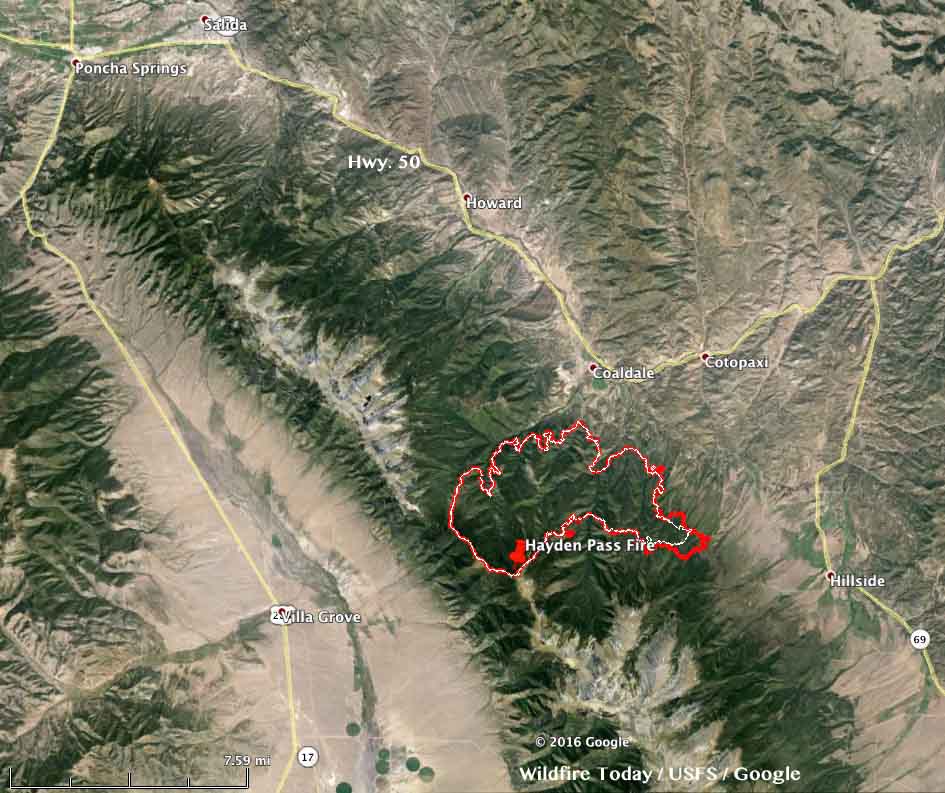
The Hayden Pass Fire 17 air miles southeast of Salida, Colorado added less than 1,000 acres on Tuesday mostly through activity on the southeast side but also on the north side. Dozers constructed fireline from Hayden Creek toward Big Cottonwood drainage while a hotshot crew built line from Big Cottonwood drainage toward Hayden Creek and the dozer line. Aircraft were used in those areas to slow the fire and support firefighters on the ground.
The fire is still 1 to 2 miles southwest of Coaldale.
The weather on Wednesday could be conducive to additional fire spread. The forecast for the fire area 3 miles south-southwest of Coaldale predicts 85 degrees, relative humidity in the low teens, and a west wind at 10 to 13 mph.
Evacuation information is at the Fremont County Sheriff’s Facebook page.
****
(UPDATED at 8:56 p.m. MDT July 12, 2016)
Judging from the state of the Hayden Pass Fire at 2:04 p.m when the heat-sensing satellite took a look at it, the blaze was much more sedate than the previous two days. However at that time there were several hours left in the most intense part of the burning period and it could have become more active for a few hours. The satellite at 2:04 p.m. only detected one area where the fire was actively spreading, the extreme southeast corner. In the map below from Monday night at 10 p.m., it would be the tip of the red perimeter at the bottom of the map. (The 3-D map is looking toward the northwest.)
****
(UPDATED at 9:34 a.m. MDT July 12, 2016)
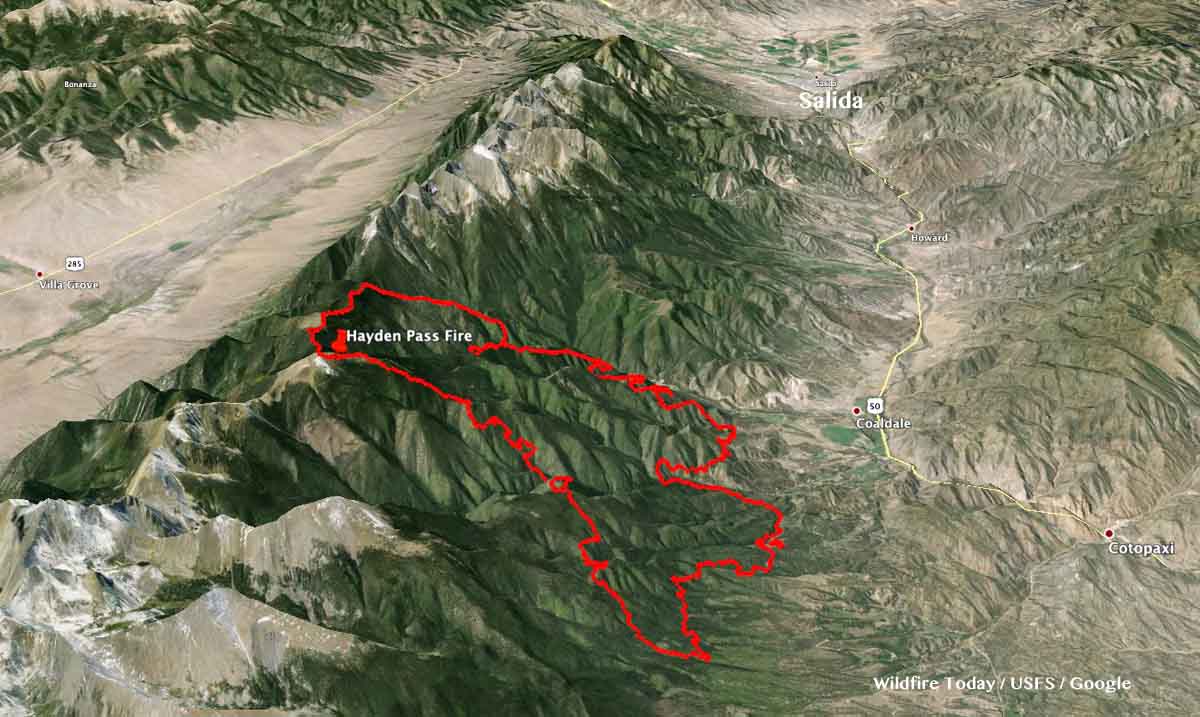
The spread of the Hayden Pass Fire southeast of Salida, Colorado slowed Monday evening after the wind diminished. As recorded by a weather station at Salida, from 9 a.m. until around sunset a strong 15 to 30 mph west wind pushed the fire with gusts of 24 to 36 mph. After midnight it was only blowing at zero to 7 mph while the temperature dropped to 50 degrees and the relative humidity increased to 48 percent.
The fire was reported Friday, July 8 and has grown substantially toward the east and southeast over the last 36 hours. So far it has burned in high elevation unpopulated areas and no homes have been destroyed, but it has spread into the lower elevations and could move closer to Coaldale and Highway 50 on Tuesday. Monday evening the fire was mapped at 12,012 acres.
Evacuation information is at the Fremont County Sheriff’s Facebook page.
The burning conditions on Tuesday will be much more benign than firefighters have seen over the last two days. The forecast for the fire area calls for 82 degrees, southwest and west winds of 8 to 10 mph, mostly clear skies, and almost no chance of rain.
The fire is about 1.6 miles southwest of Coaldale and 17 miles southeast of Salida.

As of 6 a.m. today the fire is being managed by the Rocky Mountain Incident Management Blue Team, with Incident Commander Jay Esperance.
UPDATE: #HaydenPassFire grows to 12,000 acres Monday; mandatory evacuations ordered: https://t.co/OmrDbfgdqr pic.twitter.com/6izzgg2qFz
— The Denver Post (@denverpost) July 12, 2016
****
(UPDATED at 6:12 p.m. MDT July 11, 2016)
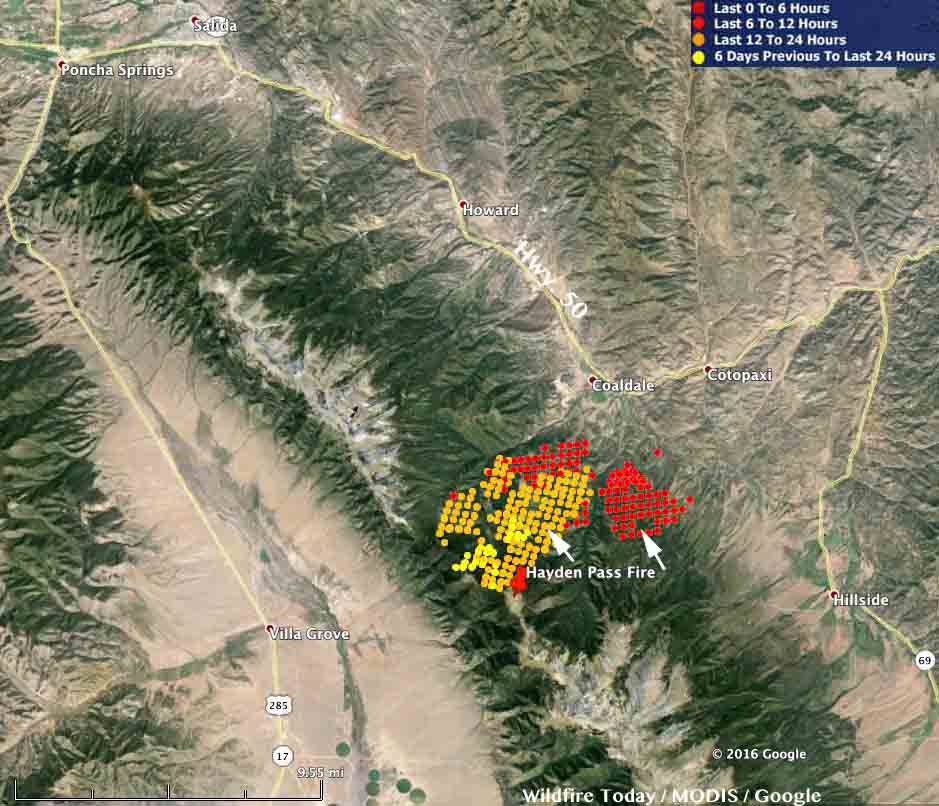
The Hayden Pass Fire 19 miles southeast of Salida, Colorado has been very active over the last 12 hours, adding several thousand acres to its total. Our very rough, unofficial estimate puts it at about 8,000 acres as of 2:23 p.m. July 11, 2016. At 5:30 p.m. a spokesman for the Bureau of Land Management Front Range District reported it was approximately 10,000 acres at that time. The good news is that no structures have burned.
Mandatory evacuations are still in place.

Fire spokesperson: Aircraft has been diverted to other fires. Requests in, but no aircraft received. #HaydenPassFire
— Emily Allen KRDO (@EmilyAReports) July 11, 2016
The 747 Supertanker based in Colorado Springs has not received certification from the Interagency AirTanker Board, so it can’t be used on federal fires. A decision from that Board, however, does not affect state or county agencies, which could contract for the aircraft. But at this time it is down to repair damage caused by hail.

****
(UPDATED at 3:55 p.m. MDT July 11, 2016)
The GOES East satellite easily detected smoke from the Hayden Pass Fire on Monday afternoon.
****
(Originally published at 1:25 p.m. MDT July 11, 2016)

The Hayden Pass Fire that started July 7, 2016 19 miles southeast of Salida grew substantially overnight. Our very unofficial estimate based on heat detected by a satellite indicated that it had burned approximately 5,000 acres as of 3:05 a.m. on July 11 and was about 3 miles southwest of Coaldale. At that time the fire was very active. KKTV reported at 1 p.m. today that the U.S. Forest Service estimated the size at 7,500 acres.
As of noon, here’s the updated #HaydenPassFire evacuation map: pic.twitter.com/l7WizzIrgA
— Barrett Tryon KKTV (@btryn) July 11, 2016
The fire started on the San Isabel National Forest and spread into the Sangre de Cristo Wilderness on the Rio Grande National Forest.
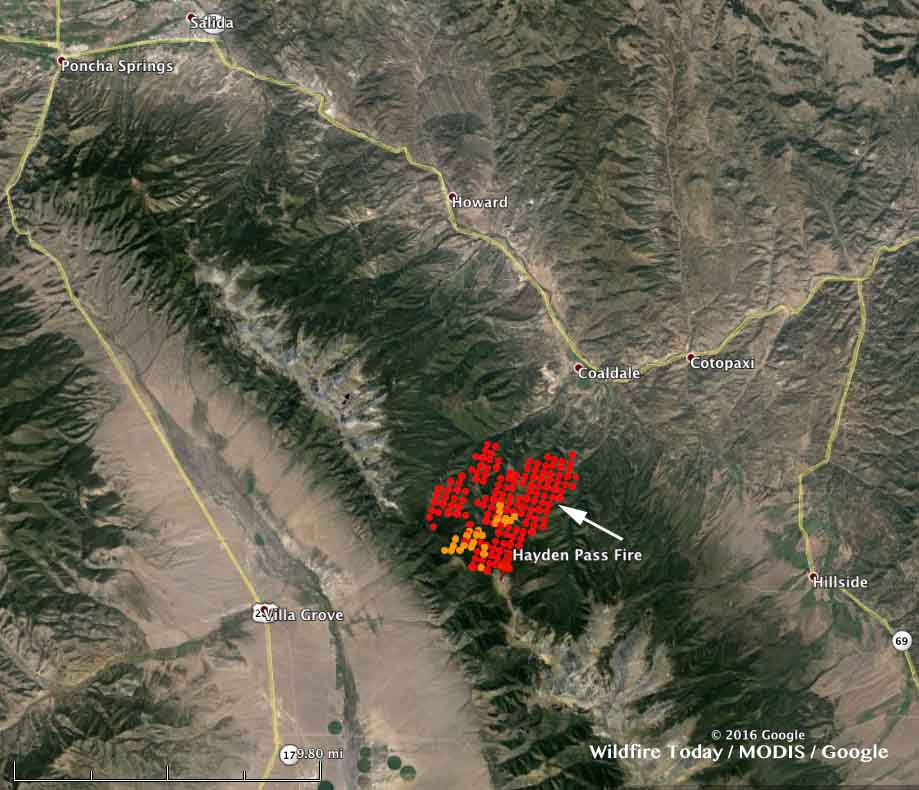
The area is under a Red Flag Warning on Monday. The weather forecast for the fire area for Monday is not favorable for the firefighters. It predicts 82 degrees, a 22 mph wind out of the west, and relative humidity of 14 percent. The prediction for Tuesday is not as severe.

#haydenpassfire has come over a ridge and massive flames and smoke pic.twitter.com/nkYJmDbLjf
— Adam Knapik (@adamknapik) July 11, 2016
View of #HaydenPassFire from San Luis Valley side of mtn from my friend Debbie. Insane smoke- #wildfire @CBSDenver pic.twitter.com/ApSxsiFHkt
— Matt Kroschel (@Matt_Kroschel) July 11, 2016


Bill, once again we are experiencing the new normal. Why throw everything but the kitchen sink at this fire. The fire managers are finally learning. Now we must uneducate the public, we do not put these gobblers out when they start running. We need to herd them, steer them, drop back and make stand(s). The VLAT is impressive but when these monsters are doing their thing, almost any amount of slurry being dropped is for show. Until we start educating the fire community, other partners, local governments, and then the general public it will be confusing…more responsible, effective…hell yes. Welcome once again to our new normal.
Eric, thank you.
I ask primarily because I do not trust the info I am getting. Typical political BS and they had the gall to tell us that it was either ” coming under control or partially controlled” when it was obvious to anyone with sense ( and eyes) that it was no such thing! Even now there is little info on our side of the fire ( Wet Mountain Valley), where we have neither tankers nor people except to block the road to Lutheran Camp, or 1A due to sightseeing. Like me, they mostly live here. There are more homes on this side, with fire right up to the edge!
Connie – the fire IS out of control. That’s why almost 700 people are working on it, and more are coming. You can get more information at http://inciweb.nwcg.gov/incident/4849/ , including information about a public meeting set up Friday specifically to answer questions the public may have. There’s also a link on that page to the pubic information phone number, if you have questions or concerns. They can probably explain much better what is going on than any of us adding comments to the article above.
As far as I can tell, this fire appears to be pretty much ” out of control”! At what point do these people decide that enough is enough??
Once again we have burning embers falling on us.
Pat, thanks for the clarification on the aircraft. I’d only gotten so far as deciding that AT probably meant Air Tanker but that was it. I’m retired AF, with my own set of acronyms, and if you try hard enough you can work a few of them out…but by no means all. So what is R4? Likely I should’ve asked my sister in law as she used to fight fires as part of NPS.
The thing that angers and confuses me most is some of these decisions to ” Let it Burn!” Every time they allow that out here it rapidly gets out of hand/ out of control! One would think it would be more sensible to put the fire out as quickly as possible. The area that’s burning now is what had ” come back” from the Duckett fire in 2011!
And now, the animals who managed to escape will be back and causing local problems. Nothing like job security.
Decades ago I was on several R 4 air tanker contracts (LAT) and did feel trapped within the Region. In a “slow year” very frustrating. Two years ago a fire in Amador County near Plymouth, Ca. explodes (mad and dangerous) into an area noted for world class wine and wineries. Cal Fire immediately made the request for the closest VLAT which was in R 4, Salt Lake City? One hour and fifty minutes later the VLAT arrived on scene. Good work by NIFC and GACC for filling this order so quickly. As mentioned the speed of the new jet air tankers is a game changer. (hate that term).
Connie, a lot of the other acronyms people were using were for kinds of firefighting airplanes — SEATs are single engine air tankers, LATs/VLATs are large or very large air tankers. IA is initial attack, the first response to a fire, when fire fighters look at how big and hazardous a fire is and decide whether and how to attack it. Most fires that are suppressed are extinguished during IA; the ones you read about in the news are the few that escape and perhaps become big “campaign” fires that require many resources to combat them.
Does anyone know if the Hayden Creek campground, about 6 miles up route 6 from Coaldale, was affected by the fire?
Thanks Bill, about what I’d guessed. Nobody however, has even mentioned those of us on the east side of the fire. We are catching most of the smoke and ashes and now burning embers as well. The area on this side was hit just a few years back ( Duckett Fire) in the same general area. Eagle Peak west off 1A was just evacuated and there are many homes in that general area. Guess we’ll head for the meeting at 6 pm. I’d dearly love a few straight answers ( comment not meant for you). We appreciate your explanation.
Thanks
Thanks, that was very helpful.
Could someone please explain what some of the ” lingo” and abbreviations mean? Who is GACC?
Thanks
This is from the National Wildfire Coordinating Group’s Glossary:
Geographic Area Coordination Center (GACC)
The physical location of an interagency, regional operation center for the effective coordination, mobilization and demobilization of emergency management resources. A coordination center serves federal, state and local wildland fire agencies through logistical coordination of resources throughout the geographic area, and with other geographic areas, as well. Listings of geographic coordination centers and their respective geographic coordinating areas can be found within the National Interagency Mobilization Guide.
By the way, we are off Reid Road and are now getting large embers and ashfall!!!
Whoever is running this circus appears to be doing little or nothing! We were just over there, and no planes and few people. Firemen just standing next to the road with binoculars.
This is not a “full suppression” fire. They do not intend to put it out totally. They want it, in some areas, to do it’s own thing to benefit the natural resources, since that environment evolved with fire as a regular visitor to the landscape. Where and when they decide it is necessary, firefighters may herd it around or suppress portions of it. But they absolutely do not want structures or private property to burn or residents to be endangered.
Started as a lightning fire which could not be detected. Is this an area that the new Colorado Fire Authority (PC 12 airplane) would have flown and pin-pointed a heat source? Jason good point. Tankers and QUICK initial attack can be the best chance for containment. M, marked as a R 4 tanker, like a “D” on the nose and tail? Tankers were marked by contract regions; “A” R-1, “C” R 3, ……….R 8 “H”. Hayden Pass is a good example of Mother Nature letting us know who is still boss. Time and weather will determine the outcome.
Not marked in that way Johnny but from what I was told by the crew is that when they were at a different base the base manager told them that they had been marked a R4 tanker by the GACC and the GACC wouldn’t be letting them leave. I thought that all LATs were still moved around accordingly by NIFC. Im sure that if we were at a PL3 or 4 Nationally that wouldn’t be happening. I also saw first hand how they were not going to be allowed past the iron curtain of the GACC. There was a fire that they had a possibility to be dispatched too and they were not going to be allowed to fly out of region to the closest base which was only 60 miles away instead they would have to fly to a base that was 100+ miles away because they had to stay within the GACC. In my humble opinion that is not using the resource wisely or in a fashion that benefits the boots on the ground.
More Lame Duck excuses! Too many chief and not enough indians…so typical these days!
How can I add a photo? Have a great one from the first day. Near Hillside
You can send us a photo from the Contact Us page.
I thought those days of hording air tankers was gone, guess not. If the Supertanker folks are waiting on the Feds, might as well push her (744) back into the hanger. It was CDF that signed off on the DC 10 while the Feds pondered will it work? A close friend (OPS) order the DC 10 a few days later on a Southern California fire and the rest was history. Tip of the day: Castle, Cal Fire, recharge compressor. Work the pricing based on a medium of cost per gallon delivered somewhere between a SEAT and VLAT.
I thought those days were gone too, but I spoke to a pilot who told me they had be marked as a region 4 tanker.
The GACCs are playing their hold on to tankers game. There are tankers 3 in the Great Basin that have been sitting not to mention a lot of SEATs.
Maybe those three air tankers sitting in the Great Basin were there for initial attack purposes in that GACC so that we don’t get another Hayden Pass fire on the landscape. Heavy air tankers are primarily an initial attack tool and not meant for constant large fire support. This is why they are spread out in places where a fire isn’t necessarily burning at the moment.
I am well aware that LATs are great IA platforms. However hording resources when a large portion of the GACC has gotten wetting rains as well as cooler temps is unacceptable. I think that people forget that most takers today have a 300 knot plus cruising speed and can get to new starts fairly quickly even if they are in a different GACC. Every aircraft can be diverted to new starts from the large fires they are on. Even without the LATs in the GACC there are plenty of SEATs available for IA.